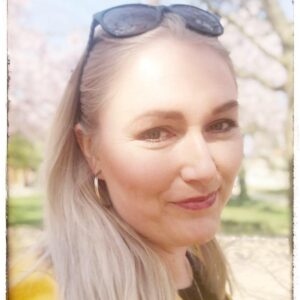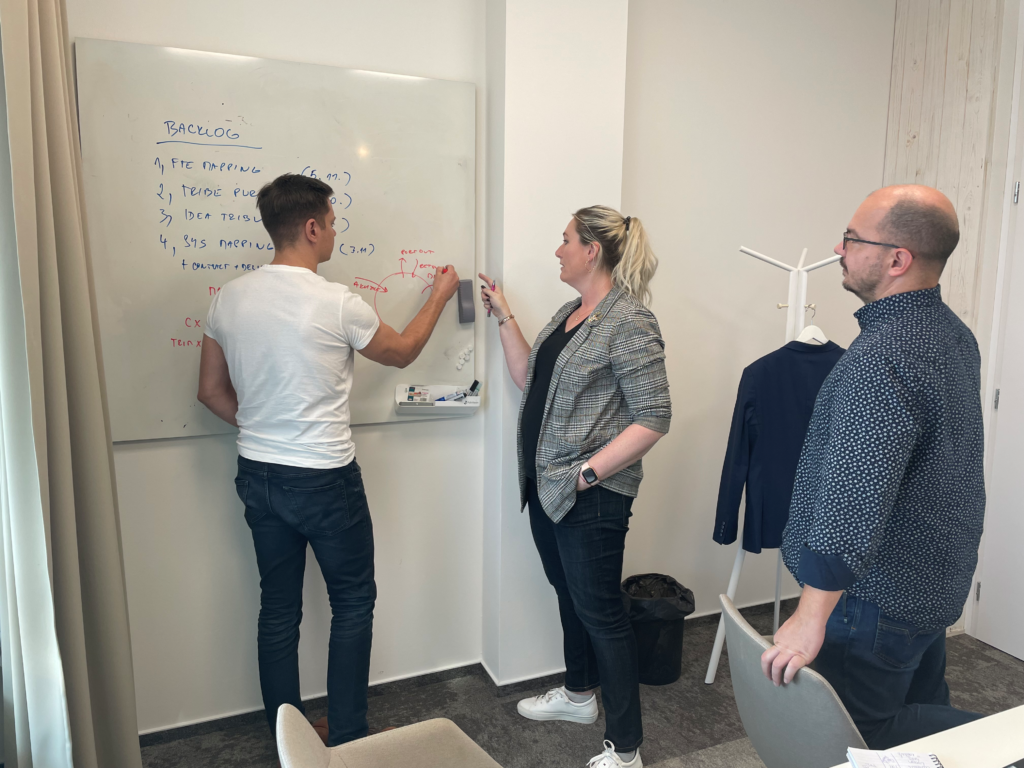Everything was new to most people at T-Mobile — Agile thinking, concepts (Tribes, Squads), methodology (Scrum, OKRs). There was a need to provide someone to help virtually transform a traditional organization into this new world that would be “faster”, “better” and “more successful”.

At the beginning of the cooperation (autumn 2021), three pilot ones were defined, so called. Lighthouse Tribes. Size was the key. Pay as you go (PAYG) — Tribe, which had cross-functional teams for some time and Agilita was the next logical step, TV CZ and TV SK suitable for Agility because they were parts that had a limited product in turn.
The cooperation took place in the period autumn 2021 — December 2022, at the moment we continue coaching and ad-hoc mentoring of leaders. In total, the collaboration involved more than 100 people. This case study describes our work in the PAYG Tribe.
PAYG Tribe
Pay as you go, or PAYG Tribe, has as its products that develop both business and technology, prepaid cards T-Mobile Twist and other brands like Cactus, Mobil.cz, etc. In total, the transformation involved 25 people, who were divided into 4 squads as part of the design. The Tribe leader of this Tribe is Andrea Kilinger, who also worked with us to create this case study.

How did mutual cooperation begin?
A series of meetings took place in autumn 2021 in order to define and design new Tribes according to one of the scaling models, the so-called Spotify modelwhich the client chose. The transformation of the entire company was primarily managed by an international consulting company, we were in charge of the design and start-up of the mentioned Tribes.
We conducted joint meetings with Tribe and Tech Leads and internal coaches 2x a week, where we went into the necessary detail and handled the items agilely from Tribe of the transformation backlog defined by us. The backlog included topics such as Agile Planning at Tribe level, what OKRs are and how they differ from KPIs, how to make a Tribe card and Tribe memo (basic description of Tribe — purpose, organizational division, key roles, goals in the form of OKRs for the year and quarter).
“At T-Mobile, no one had any prior hands-on experience with Agile type management. Agile functioning within IT, based on the SAFe methodology that worked in the company until that moment, was not an ideal model and was a rather illegible organism for business people,” says Tribe lead PAYG, Andrea Kilinger
What did we do at Tribes specifically?
First of all, we defined the purpose and goal of Tribes, then structure (Squads), necessary roles and competencies (Squad members, Chapters). After that, it took place recruitment to the key role of PO, which we attended and provided a person's perspective from the outside and an Agile expert's perspective on the candidate's suitability.
“In recruiting for me, your role was again quite crucial, because mostly internal candidates knew each other, the opinion of a person outside the perimeter was very valuable. I also think that Roman arranged meetings with real live 3D people who work in Agile and have survived the transformation of their companies. Thanks for that! It was very encouraging!” adds Andrea.
Next, together with our in-house Agile coach Lukáš, we prepared an Agile bootcamp at the beginning of January. On it took place the official launch of Lighthouse Tribes. Since COVID was in full force at the time, everything was going online. The aim of the Bootcamp was to:
- To learn experientially what Agility is and specifically the SCRUM framework.
- Define the so-called Squad card — i.e. The identity of the Squad (team), why we exist, what our goals are, agree on joint functioning (communication channels, regular meetings, work with JIRA).
- Introduce the steps for the following week and the overall scheme of the first quarter.
It was agreed with the Board that Q1/2022 would be pilot and roll-out with the aim of fitting everything into a new way of operating and thus not expected to meet ambitious targets or deliveries. However, the fulfillment of the annual company KPIs was expected. The main goal was for clients not to feel negatively that internally some kind of transformation was taking place. After this decision and transparent communication to the company, everyone was clearly relieved.
What was our role and what were the biggest challenges we faced?
The role of RainFellows was to give support mainly to Andrejce (Tribe Lead PAYG), Pavel (Tribe Tech Lead PAYG) and Lukáš (internal AC for PAYG). The goal was to have at the end of Q1 not only Tribe, in which the vans operate, but also leaders firmly established in their roles and independent of Rainfellows/Roman. Beyond the joint meetings, it was Supporting leaders primarily in regular 1on1 meetings, where we discussed topics related to the performance of their role in the form of mentoring and provided answers to their questions, such as dealing with specific situations or supplying missing know-how. Later mentoring switched in coaching on topics that the leaders themselves brought up.
The biggest challenge we faced during the design phase was the End-to-End (E2E) composition of the Tribe. The pressure was to leave only PAYG business competence and IT/supply to other Tribes. But what is it about Agile? Our priority was to get as close as possible to the ideal of autonomous, E2E Squads. This eventually proved crucial to reducing Time-to-Market, ensuring needed supplies, and feeling good among Trib people that they were finally in control of important decisions. For a great improvement in standard delivery, we set a value of less than 45 days. Gradually, we achieved a significantly better value in the first quarter, namely 33 days.
“RainFellows has continuously given us confidence and determination in some important decisions. The moment you start on the green field, you build Tribe, a complex ecosystem of business and technology people with high expectations, you feel a huge responsibility.”, mentions Pavel.
The challenge was not only to assemble a functioning E2E team, but also that Lighthouse Tribe had to find a way to continue to support existing supplies from the still valid and developed project roadmap. In this “dual” mode, communication, quick decision-making, and especially experience of complex transformations are important.
From the very beginning, it was shown how important business and technology cooperation is. When designing our Pay as you go Trib, we focused mainly on E2E delivery capability. Therefore, we relied on a roadmap simulation, which was prepared by appropriately selected business representatives and technology colleagues enriched with expert estimates. This simulated list of the most important and most frequently needed roles and systems was a guide for us to define variants of the definitions of the necessary competencies.
“It is always an advantage if people who can speak business and speech technology help. This RainFellows “putty”, charged with Roman's energy and insurmountable streams of laughter, helped keep the mood even in moments when it was uncertain whether the proposed design would work. Deeper IT knowledge has proven to be an advantage in debugging technological processes on existing, often still monolithic systems. The big challenge is to find a form of agile collaboration of development teams in different tribals over one such system. Finding a partner who understands the benefits of cloud-native microservices for our complex environment was also crucial for finding a suitable way to implement Trib's design into reality.”, adds Pavel.

As shown in the next steps of the transformation, dependencies during planning lead to an increase in complexity at the level of the central QBR process. It then lays claim to a “fair” system of prioritization and reliable estimates. Central Tribes, delivering for many others, simply become a place of necessary prioritization with increased complexity, as does the entire QBR process. In contrast, in our Tribe, prioritization and estimation were significantly easier. It was basically a brainstorming session on two key questions:
- What do we need to do to fulfill our OKRs?
- Can we do it within 3 months with our capacities?
Anything that can be discussed within the Squad or Tribe is easier. There is no need to invent a universal key for prioritization and estimation across the company.
Not all dependencies managed to cut off during design. With large companies, rarely is the Tribe completely independent of its surroundings. A few critical dependencies remained on the central tribes, which implement any changes to systems whose modifications could not be distributed to the tribes. To avoid conflicts in priorities, it was important to agree on a long-term strategy (Tribe independence) and how to ensure current quality (Central Tribes). The agreed process then fell out of the joint negotiations.
What was the result?

The intensive cooperation took place between October 2021 and September 2022. As usual after a couple of months after such a major change, we were expecting negative Tribe ENPs. But this ultimately turned out not only positive, but was also quite high. The first measurement at the end of Q1 showed a value of 16, the following quarter we were at 32 and at the end of Q3 we reached a value of 55.
“This is one of the best things that has happened to me in the last X years in TMOB”, reviews a member of the PAYG Tribe
After this period, the already mentioned mentoring and coaching of Tribu leaders continued until the end of 2022. After minor fluctuations caused by the next wave of Agile Transformation, we are already During Q4, they even reached a Time-to-Market (TTM) value of 22, significantly exceeding the original plan..
What PAYG T-Mobile awaits next?
Two Squads out of four in PAYG are up and running according to SCRUM without major problems. We transferred two BAU (Business As Usual) Squads to Kanban after the first quarter as planned. For one, this new way of working has taken hold, for the other, we need to redefine the items that are tracked in Kanban and thus have all the work visible in one place.
At the strategic planning (QBR) level, cooperation does not crumple fundamentally, the exceptions being the estimates and overloading of one central Tribe — see the challenges paragraph above.
It is now important for the entire Tribe to define its strategy, but this is not directly related to the implementation of Agility.
Experience through the eyes of leaders
With Andrea and Pavel, we analyzed the process of the whole transformation in detail in our show Agile Talks on Red Button EDU. Listen to what worked very well from their point of view during the transformation, what worked well for them and what, on the contrary, they recommend doing differently.


